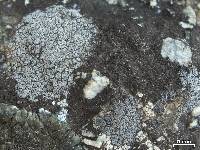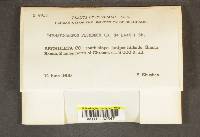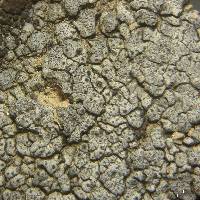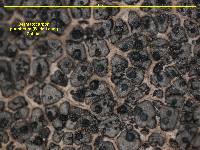
Consortium of Lichen Herbaria
- building a Global Consortium of Bryophytes and Lichens as keystones of cryptobiotic communities -
- Home
- Search
- Images
- Species Checklists
- US States: O-Z >
- US National Parks
- Central America
- South America
- US National Parks
- Southern Subpolar Region
|
|
|
|
Family: Verrucariaceae
[Catapyrenium plumbeum (B. de Lesd.) J.W. Thomson, moreDermatocarpon plumbeum B. de Lesd., Endopyrenium plumbeum B. de Lesd.] |
Nash, T.H., Ryan, B.D., Gries, C., Bungartz, F., (eds.) 2007. Lichen Flora of the Greater Sonoran Desert Region. Vol 3. Life habit: initially lichenicolous, starting as a parasite on Staurothele sp. in small patches, later becoming independent Thallus: areolate, when independent forming large colonies up to several centimeters across, 0.2-0.4 mm thick (up to 1 mm including the stipe-like attaching organs), without an apparent prothallus areoles: angular to somewhat rounded, rarer slightly incised (especially those at thallus margin), flat to slightly convex, (0.5-)1-2(-2.5) mm wide, close together or becoming separate, basally ±constricted, fastened by a central hyphal bunch, marginal parts of lower side free and pale brown to black surface: whitish or bluish gray, dull, roughly pruinose anatomy: upper cortex: composed of ±round, angular cells 4-6 µm in diam., 15-20 µm thick, with a pale brown outer cell layer, overlain by a thick amorphous epinecral layer 20-40 µm thick; with cortical paraplectenchyma continuing along the side walls to the free lower sides of the areolae; algal layer: continuous, with algal cells 7-10 µm in diam.; alga-free medulla: ±cellular or with filamentous parts especially near the attaching points stipes: formed largely by longitudinally arranged hyphae with substrate particles in between Perithecia: immersed in the areoles, one to several per areole, entirely sunken or with slightly protruding tips; exciple: subglobose or broadly ampulliform, pale at first but black around the ostiole, then darkening throughout; involucrellum: lacking; periphyses 25-35 µm long, 2.5-3 µm thick, simple asci: clavate, 60-75 x 15-23 µm, 8-spored ascospores: hyaline, simple, broadly ellipsoid, 12-15(-16) x 7-9(-10) µm Pycnidia: immersed, 50-80 µm wide, in surface view appearing as small black irregular dots often in small depressions of the areoles conidia: bacilliform, 5-7.5 x 1 µm Spot tests: all negative Secondary metabolites: none detected. Substrate and ecology: parasitic on thalli of Staurothele species at least when young, later often becoming independent, epilithic, over siliceous and calcareous rocks, mostly sandstone, in dry open sites at high altitudes World distribution: widely distributed and locally common in southwestern North America Sonoran distribution: throughout Arizona and also known from Sonora. Notes: There are three externally similar species that start their life cycles as parasites on Staurothele hosts and may later become independent. In the latter case thalli of their host species are usually found in close proximity (also in herbarium samples). For distinction of these species see under Verrucaria bernardinensis. |
|
|
|
Powered by Symbiota









































